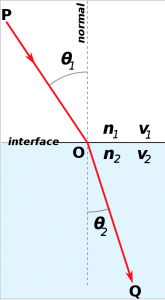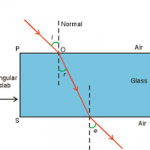The study of light encompasses many phenomena. Optics is a vast subject, and one of the most important concepts in optics is refraction. In order to understand refraction, we generally study prisms of different shapes and how light behaves with them. Read on to know more about rectangular prisms. (i.e glass slabs) and refraction.
Whenever you view an object through a glass prism of any shape, you always find it to be either displaced or distorted. This is due to certain rules followed by light in the way it propagates. To understand why this happens we must start with understanding the duality of light.
Duality of light
Physicists have long debated the nature of light. Light first considered to be particulate by Pierre Gassendi, and later by Isaac Newton. Both saw light as corpuscles that travelled in straight lines and were emitted in all directions. The photoelectric effect observed by Hertz and other scientists seemed to confirm this. However, there seemed to be a slight problem.
While the reflection of light can be explained by corpuscular theory, refraction could not. Light also experiences interference and diffraction, which are all wavelike characteristics. Huygens, Young, and Fresnel later came up with experiments that prove light to be wave-like. Although these experiments were logically convincing, phenomena like the photoelectric effect could not be ignored.
Hence, light was finally accepted to exist in a dual state as both particle AND wave. Understanding what prisms do to light involve studying light as a wave. The phenomenon in question is refraction.
Refraction
When light passes from one medium to another, it actually changes direction instead of passing through straight. As a result, the image can either be shifted or distorted. For example, when you look at a pencil that is half-submerged in a glass of water, you notice it appears distorted.
Refraction occurs with every wave passing from one medium to another and follows certain laws without exceptions:
The incident ray, refracted ray, and the normal to the point of incidence all lie on the same plane.
Snell’s law (see below)
Note: To understand Snell’s law, we must have a little introduction on refractive indices.
Refractive index
The refractive index of any medium is a number that describes the speed of light in that medium. This number is dimensionless and is the ratio of the speed of light in vacuum to the speed of light in that medium.
Let the refractive index of a medium be n and the speed of light in that medium be v. The speed of light in vacuum is c.
According to the definition of refractive index, we get
n=v/c
Snell’s Law
Most physicists express laws in terms of mathematical equations. Snell’s law is no different. It describes how the angle of incidence and angle of refraction of a ray of light are related.
Consider this picture:

Here, we see that light is travelling from medium 1 (white) to medium 2 (blue). Medium 1 has refractive index n1 with speed of light in medium as v1. Medium 2 had refractive index n2 with speed of light in medium as v2.
We see that the incident ray PO does not travel in a straight line, and refracts to form OQ.
The incident angle is θ1 and the refracted angle is θ2.
By Snell’s law,
sinθ2/sinθ1= n1/n2 = v2/v1
From further studying Snell’s law, we can conclude that if n2>n1, sin θ1>sin θ2, i.e θ1 > θ2 (assuming 0º< θ1, θ2 < 90º )
Thus, if n2>n1, the ray is shifted towards the normal, and vice versa.
Rectangular slab
Let us now consider the case of refraction through a glass slab. For simplicity’s sake, we will consider a glass slab in air. Air has a refractive index of 1. When a light ray passes through a rectangular slab, it is incident on two surfaces, namely the two surfaces that are in contact with air. Let us understand this with the help of the given diagram:

Here, we see that the ray is incident on surface P as well as S. As a result, two refractions occur.
Let us call the normals N1 and N2 from left to right respectively.
We see that i is the incident angle and r is the refracted angle at surface P. Since N1 is parallel to N2, with refracted ray as the transversal, we see that r is the incident angle at surface S. At S, e is the refracted angle, which is also known as the emergent angle.
Let n1 be the refractive index of air and n2 be the refractive index of glass.
From Snell’s law, we know that
sin i/ sin r = n2 / n1 —— (1) { at surface P}
sin r/ sin e = n1/n2 —— (2) { at surface S}
The RHS parts of (1) and (2) are reciprocals of each other, hence multiplying (1) and (2) gives us:
sin i /sin r * sin r /sin e = 1
Cancelling sin r on the LHS, we get sin i/sin e =1
Therefore, sin i = sin e, therefore i=e { as we assume that 0º< i,e <90º }
This means that the emergent ray is parallel to the incident ray.
Though the incident and emergent rays are parallel, they do not lie on the same line. This means that the emergent ray is laterally shifted by some amount from the incident ray. To find out more about this lateral displacement and how to calculate it, visit eduriefy.com today!
Master Your Coding Skills with BootSelf AI
If you're looking to enhance your coding abilities and upskill in artificial intelligence, look no further than the BootSelf AI app. This innovative platform provides AI-based coding lessons that are tailored to your individual learning pace.
Available on both iOS and Android, you can download the BootSelf AI app and start mastering coding skills today:




